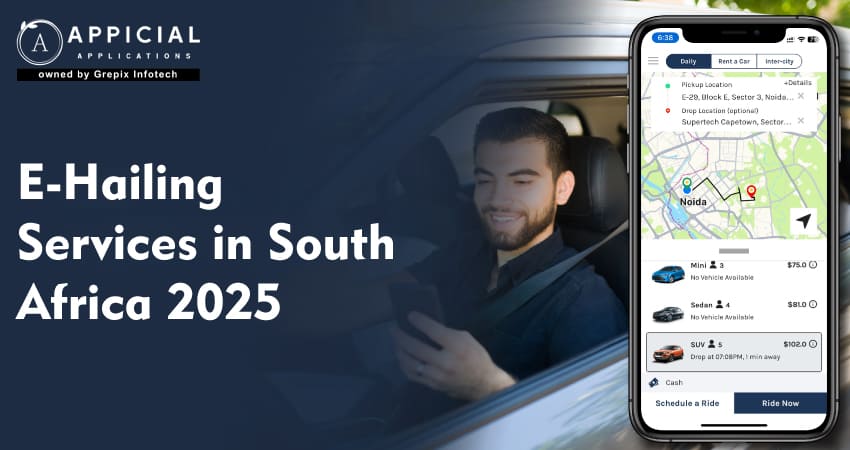
E-Hailing Services in South Africa 2025
E-hailing services have revolutionized how South Africans commute, offering convenience, affordability, and efficiency. By 2025, this transformative industry is expected to soar to new heights, driven by technological innovation, regulatory evolution, and growing demand. Whether you're a commuter, a driver, or a stakeholder, understanding the trends shaping this dynamic sector is critical.
Let’s delve into the world of e-hailing services in South Africa and uncover what the future holds.
E-hailing services have revolutionized commuting in South Africa, offering convenience, affordability, and efficiency. By 2025, the industry will reach new heights, driven by technological advancements such as AI, EVs, and 5G connectivity, alongside evolving regulations and customer expectations. Major platforms like Uber and Bolt dominate urban markets, while local players address underserved areas. The industry’s focus includes safety innovations, sustainability goals, and rural expansion. Appicial Applications, a leader in mobile app development, supports businesses with cutting-edge, scalable solutions to thrive in South Africa’s dynamic e-hailing sector. Partner with Appicial to redefine e-hailing and shape the future of transportation.
E-Hailing Services in South Africa- Step-by-Step
The Evolution of E-Hailing Services
E-hailing has come a long way since its inception, offering a stark contrast to traditional taxi services. Initially viewed as a luxury, it quickly became a necessity for millions of South Africans, thanks to its reliability and ease of use.
Key milestones in South Africa:
- 2013: Uber’s launch marked the beginning of the e-hailing era.
- 2016: Bolt (formerly Taxify) entered the market, intensifying competition.
- 2020: COVID-19 accelerated the need for contactless transportation solutions.
- 2025: A fully integrated system that balances safety, affordability, and environmental responsibility is anticipated.
This transition underscores the industry's shift from convenience to a necessity embedded in daily life.
Market Leaders and Emerging Players
The e-hailing market in South Africa is dominated by global giants like Uber and Bolt. These platforms have built strong networks that provide competitive pricing and advanced features.
However, local startups are entering the scene with innovative offerings tailored to the South African context. Companies like Yookoo Rides and Droppa are gaining traction by addressing localized challenges, such as service affordability in underserved areas.
This mix of competition and collaboration is driving innovation, benefiting both consumers and the economy.
Technological Advancements Shaping the Industry
Key innovations include:
- Artificial Intelligence (AI): Optimizing routes, reducing wait times, and enhancing customer experience.
- Electric Vehicles (EVs): Gradual adoption to align with sustainability goals.
- 5G Connectivity: Boosting app performance and enabling real-time updates.
These advancements not only improve efficiency but also set the stage for a greener, more sustainable future.
Regulatory Landscape for E-Hailing Services
The e-hailing industry in South Africa faces significant regulatory challenges. Existing frameworks often lag behind the rapid pace of innovation, leading to conflicts between companies, drivers, and local authorities.
In 2025, we can expect:
- Stricter safety regulations to protect passengers and drivers.
- Policies promoting the use of EVs and eco-friendly practices.
- A balanced approach that ensures fair competition and service affordability.
Navigating these regulations is key to the industry's long-term success.
Addressing Safety Concerns
Safety remains a top priority for e-hailing services. Companies are investing heavily in measures to protect both passengers and drivers.
Initiatives include:
- In-app SOS featuresfor emergencies.
- Driver background checks and training programs.
- Dashcams and GPS tracking for real-time monitoring.
Feedback from communities plays a crucial role in shaping these safety initiatives, ensuring they meet the unique needs of South African users.
Also Read: South Africa's Top 10 Taxi Apps: Transforming Urban Transportation
Economic Impact of E-Hailing Services
E-hailing services have significantly influenced South Africa’s economy, acting as a lifeline for job creation and mobility. By 2025, the industry’s contributions are expected to deepen, fostering direct and indirect economic benefits.
Job Creation:
- Thousands of drivers have found employment opportunities, either full-time or part-time, giving individuals a flexible income source.
- Ancillary industries such as vehicle financing and maintenance have thrived due to the increasing number of e-hailing fleets.
Contribution to GDP:
The e-hailing sector contributes to the national GDP by enhancing productivity. Commuters benefit from time-saving transportation solutions, while businesses enjoy reliable delivery services.
However, challenges persist, including fuel costs, commission rates, and increasing competition. Addressing these issues is crucial to maintaining a balanced and sustainable ecosystem.
Sustainability and Environmental Goals
The global push toward sustainability has found its way into South Africa’s e-hailing industry. By 2025, there will be a stronger emphasis on adopting green practices to reduce the environmental impact.
Key trends include:
- Electric Vehicles (EVs): Many operators are transitioning to EVs, reducing dependency on fossil fuels.
- Carbon Neutral Goals: Platforms are introducing programs to offset emissions, such as planting trees for every ride completed.
- Solar-Powered Charging Stations: Efforts to develop charging infrastructure powered by renewable energy are gaining traction.
These initiatives not only align with global sustainability goals but also appeal to eco-conscious consumers.
Rural vs. Urban E-Hailing Dynamics
E-hailing services have predominantly thrived in urban centers like Johannesburg, Cape Town, and Durban. However, expanding these services to rural areas remains a significant challenge.
Urban Areas:
- High demandfor quick and efficient transport.
- Competitive pricing and multiple service options.
Rural Areas:
- Limited infrastructure hinders expansion.
- Initiatives are underway to improve access, including partnerships with local governments and NGOs to address road quality and network connectivity.
Bridging this rural-urban gap will be a defining milestone for the industry by 2025.
The Customer Experience in 2025
Customer satisfaction is the cornerstone of successful e-hailing services. Platforms are continually evolving to provide a seamless and personalized experience.
Key enhancements include:
- Enhanced App Functionalities: AI-powered suggestions for preferred routes and schedules.
- Affordable Pricing: Dynamic pricing models ensure rides remain accessible while balancing driver earnings. Companies are also exploring subscription-based services for frequent users.
- Customization: From choosing specific vehicle types to integrating rides with meal deliveries, the future of e-hailing focuses on convenience and personalization.
The Role of FinTech in E-Hailing
FinTech integration is revolutionizing payment systems, making transactions seamless for drivers and passengers.
Key innovations include:
- Digital Wallets: Platforms are introducing proprietary wallets, allowing users to store credits for rides.
- Cryptocurrency Payments: Although in its infancy, the use of cryptocurrencies in South Africa’s e-hailing market is being explored.
- Driver Financing: Partnerships with financial institutions are helping drivers access affordable vehicle loans and insurance products.
Partnerships with Other Sectors
Collaboration is crucial for the continued success of e-hailing services. Partnerships with industries such as tourism and public transportation are unlocking new opportunities.
Tourism and Hospitality:
- Tourists can now book guided city tours through e-hailing apps.
- Integration with hotel booking platforms offers end-to-end travel solutions.
Public Transport:
- By complementing buses and trains, e-hailing services provide first- and last-mile connectivity, encouraging the use of public transport.
The Future of Ride-Sharing Beyond 2025
The e-hailing landscape will continue to evolve beyond 2025, with exciting advancements on the horizon.
Key future developments include:
- Autonomous Vehicles: While fully self-driving cars are still a few years away, the groundwork for their integration is being laid. This innovation could significantly reduce operational costs and improve safety.
- Micro-Mobility: Electric scooters and bicycles are gaining popularity, offering a sustainable alternative for short-distance travel.
- Global Trends: South Africa is expected to adopt trends such as ride-sharing subscriptions, where users pay a monthly fee for unlimited rides within specific zones.
These developments highlight the industry’s adaptability and potential for growth.
Challenges and Opportunities for the Industry
The e-hailing sector faces several challenges, including fierce competition, regulatory hurdles, and market saturation in urban areas.
Opportunities include:
- Expanding to underserved rural regions.
- Developing niche services, such as premium rides for corporate clients.
- Leveraging data analytics to improve operational efficiency.
By addressing these challenges and capitalizing on emerging opportunities, the industry can maintain its upward trajectory.
| City | Population | Area (km²) | Official Language(s) |
|---|---|---|---|
| Johannesburg | 2,026,469 | 1,645 | Predominantly isiZulu, followed by English, Afrikaans, and Sesotho. |
| Cape Town | 3,433,441 | 2,461 | Mainly Afrikaans, with significant numbers speaking isiXhosa and English. |
| Durban | 3,120,282 | 2,292 | Primarily isiZulu, with English also widely spoken. |
| Port Elizabeth | 967,677 | 251 | Mainly isiXhosa, Afrikaans, and English. |
| Bloemfontein | 463,064 | 236 | Predominantly Sesotho and Afrikaans, with English also commonly used. |
Conclusion
Appicial Applications, a leading taxi app development company, is at the forefront of revolutionizing e-hailing services in South Africa. With expertise in cutting-edge technologies like AI, IoT, and Blockchain, Appicial empowers businesses to create scalable, secure, and future-ready e-hailing solutions tailored to South Africa’s unique market dynamics.
As e-hailing services transform mobility, addressing urban-rural disparities, sustainability goals, and customer-centric innovations is vital. Appicial delivers feature-rich apps that prioritize safety, affordability, and personalized experiences, ensuring businesses stay competitive in this rapidly evolving industry. Partner with Appicial to redefine e-hailing in South Africa and drive growth in this promising sector by 2025 and beyond.
FAQs
Looking out to start your own venture like Uber ? Try out our HireMe Taxi Uber Clone, the easiest way to kick-start your taxi business.
Author's Bio

Vinay Jain is the Founder at Grepix Infotech and brings over 12 years of entrepreneurial experience. His focus revolves around software & business development and customer satisfaction.
Back to blog list






